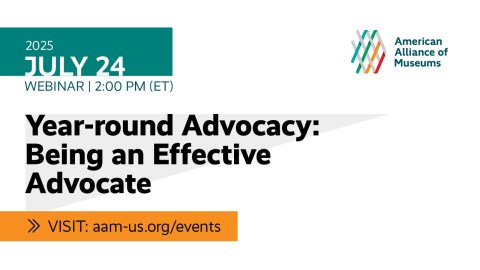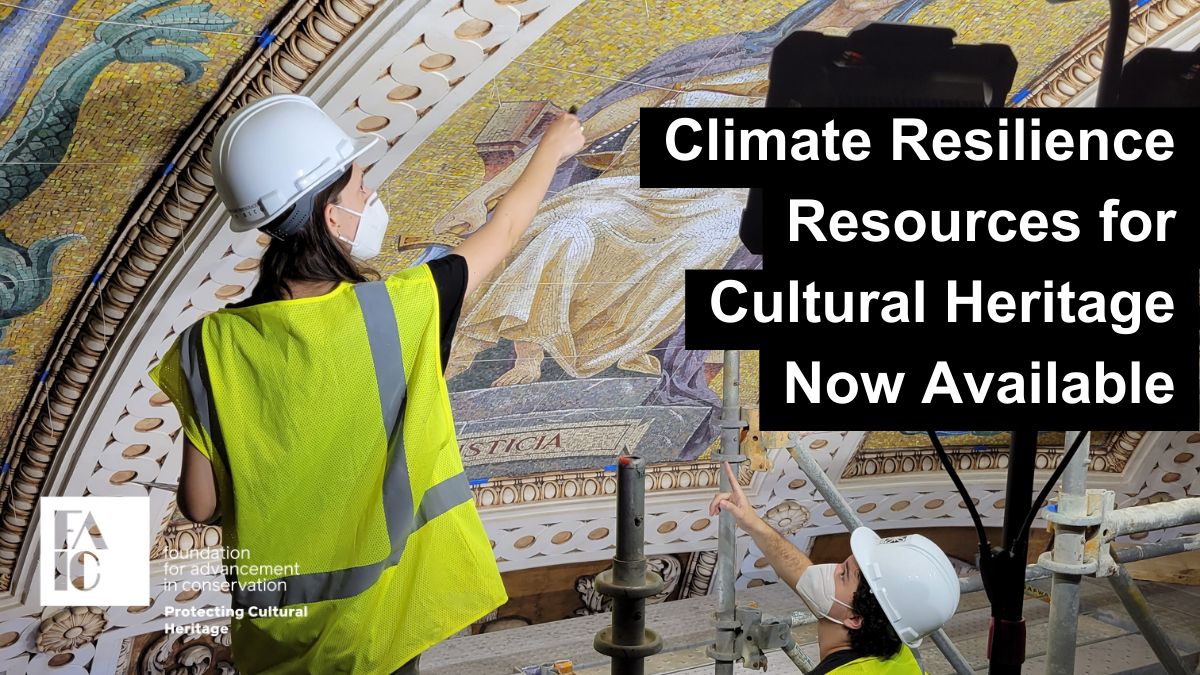
This year’s TrendsWatch report spotlights the urgent need for humanity to curb our carbon emissions if we are to stave off the worst extremes of climate change. The term “existential threat” is, IMHO, overused, but in this case it is apt: climate change threatens the safety of museums and the collections they care for, and the health and well-being of the communities they serve. In response, museums are beginning to monitor and curb their climate emissions, assess and prepare for climate disruptions, and educate the public regarding climate action. This week on the blog, Stephanie Shapiro, Co-Founder and Managing Director at the non-profit Environment & Culture Partners, tells us about newly released resources that help museums tackle these challenges. If you are attending the AAM annual meeting in Baltimore this week, join Stephanie on Sunday at 1 pm for a workshop exploring these resources and their applications.
–Elizabeth Merritt, VP Strategic Foresight and Founding Director, Center for the Future of Museums
“We are well past talking about a problem: most museums can skip the climate awareness and focus on their role in activating action in all aspects of their work, from operations, communications, exhibition, and most importantly, working with their communities to implement solutions wherever they are based…Museums are ideally suited to be catalysts for engaging the public in climate action.”
— (Fraser & Switzer, 2021, Ch. 11) (emphasis added)
Whether on an iconic scale like the Tidal Basin’s cherry blossom trees in Washington, DC, or a more local one like the cultural center in your neighborhood, climate change is impacting the people, plants, animals, things, and places we care about most. For cultural institutions, this is particularly important, since we are the keepers, protectors, conservators, and educators of the very stories, traditions, sites, and artifacts and objects that have this cultural significance.
Those outside of our sector are starting to make this connection. AAM’s 2022 Annual Survey of Museum-Goers found that 91 percent of frequent museum-goers think museums should be reducing their own carbon footprints, and 92 percent think museums should be educating the public about climate change. The United States government is also recognizing the relationship between climate and cultural heritage, including in the major Fifth National Climate Assessment report. As the report states, “Many deeply rooted community ties, pastimes, Traditional Knowledges, and cultural or spiritual connections to place are at risk. Cultural heritage—including buildings, monuments, livelihoods, and practices—is threatened by impacts on natural ecosystems and the built environment.”
Recognizing these threats, cultural organizations worldwide are already pursuing climate mitigation, adaptation, and resilience, a set of strategies collectively known as climate action. Climate action is about changing behavior and shifting from “business as usual” to thinking holistically and inclusively. Cultural organizations can decrease their carbon footprints, educate the public about climate, build resilience with communities, and inspire change and action all at once.
But many of our organizations are stymied in these pursuits by limited time, staff, and funding. To help overcome these challenges, the Foundation for Advancement in Conservation (FAIC) and National Endowment for the Humanities (NEH) created the Climate Resilience Resources for Cultural Heritage to provide free, comprehensive resources that enable cultural resource stewards in the US and its territories to begin thinking about and taking climate action. A cadre of cultural heritage, climate, and technical experts, including myself, led and contributed to the development of the resources.
Anyone who cares about a site, collection, building, or area (e.g., a cultural corridor) can develop a climate resilience strategy—you do not have to be formally trained in conservation to use the resources. The resources support institutions collaborating with one another and with their communities to examine every aspect of their current operations through a climate lens, encouraging a critical change in the way we think about preservation and work toward adaptation. This post provides an overview of what the resources include and how you can use them in your own strategy.
Overview of Climate Resilience Resources for Cultural Heritage
The resources consist of five primary components:
-
- The Climate Resilience Strategy Approach and Guide provides a sample outline and process to develop a resilience strategy. The guide recommends that users consider forming a “learning group” within and between organizations to share ideas, experiences, and planning. (Two learning groups, one in New Mexico and one in Puerto Rico, piloted the resources and developed their own resilience strategies together.) In this section, users can explore recommendations and templates for forming and sustaining learning groups of their own.
- Eight sequential Learning Modules introduce concepts about culture and climate, and provide tools needed to develop a strategy. Modules are available in English and Spanish and contain terms and definitions, core concepts and approaches, recommended readings, sources for further study, and activities. The activities allow users to apply the content and are inputs to the strategy.
- The third component introduces the interactive Hazard Risk Assessment Map, which allows users to identify and learn about the climate hazards that impact a site and community based on historical data from FEMA, as well as assess the risk of future hazards based on climate models from NOAA and ClimateCheck®. Users can get a quick snapshot of the information or dig deep into the projection details. Additional information is also available in this section, such as the FEMA Building Code Adoption Tracking which tracks the building code adoption status for state, local, tribal, and territorial governments, and the Climate and Economic Screening Tool which identifies communities that are considered overburdened and underserved.
Thanks to the private company ClimateCheck®, detailed site-level reports of any latitude/longitude in the US and its territories are also available, with examples of impacts to cultural heritage for each climate hazard. For example, here are the precipitation and projection details for the Tidal Basin in Washington, DC:
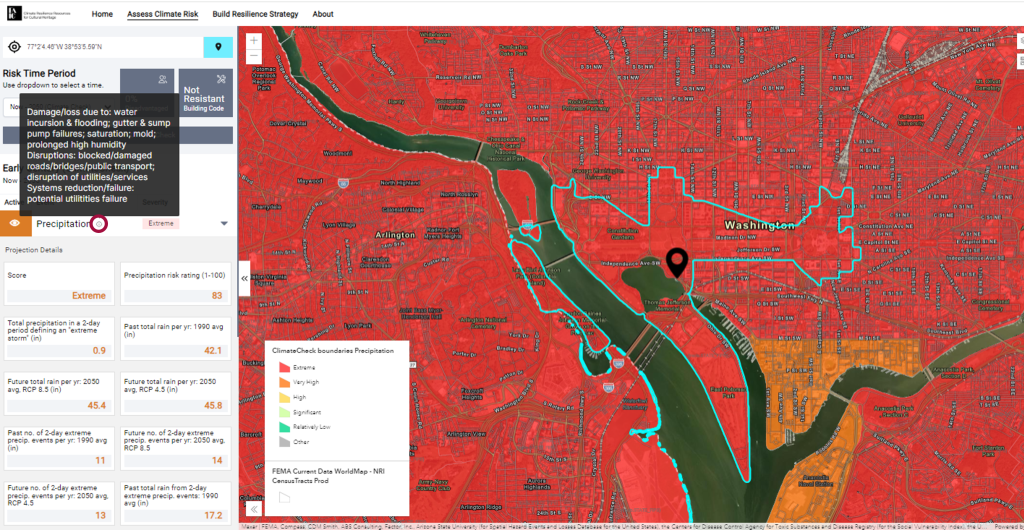
And here are the flood hazard areas for the site from FEMA’s National Flood Insurance Program:
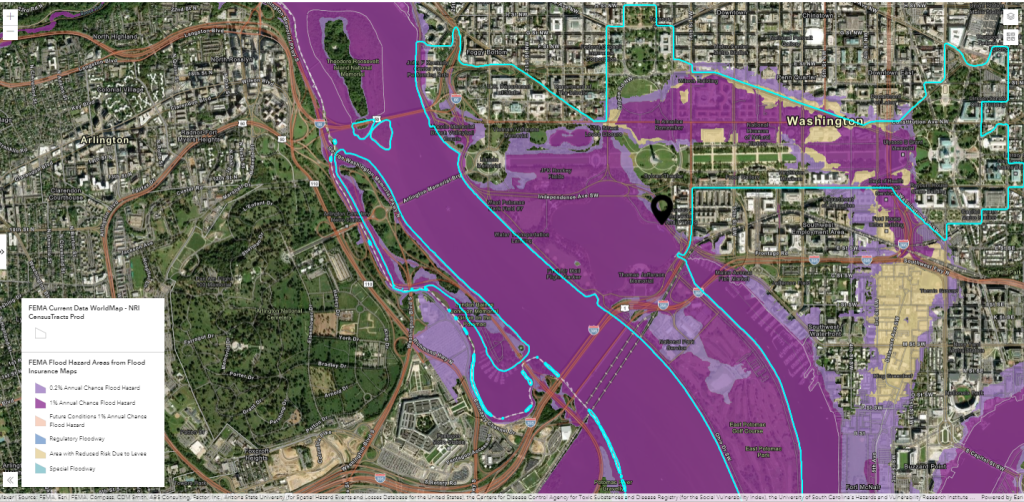
-
- The Site-Level Vulnerability Assessment Survey in the fourth component allows users to assess the likelihood of the hazard and risk of damage for each climate hazard identified by the map. This identifies specific vulnerabilities and explores actionable responses.
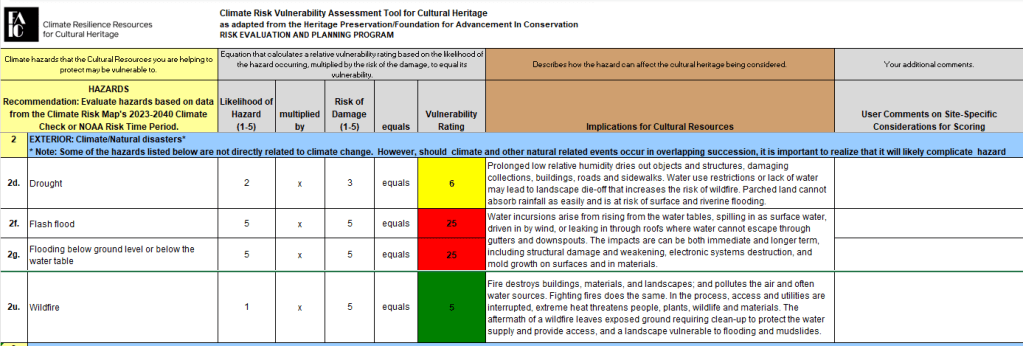
- Component five introduces the Prioritization Framework, which provides an opportunity for organizations to visually brainstorm and prioritize the resilience impact, urgency of action, and time/complexity of each activity.

The results from the map, survey, framework, and modules are all inputs to your resilience strategy. Organizations should review and update their strategy at least annually and share their ideas and successes with the field and partners. The strategy is a living document that can adapt to the needs and changes of the organization and the climate.
What’s Next?
We encourage users to use the resources and form their own learning groups with a partner or multiple institutions in order to develop their own climate resilience strategies. We plan to use feedback from users of the resource to improve and update the content. We also continue to seek funding, both to form more learning groups (as this model successfully demonstrated the power of collaborative climate action) and to continue updating the resources.
Whether it is a place in your neighborhood you care about, a collection, an archaeological site, or a building, we hope that the resources will help you, your organization, and community begin or continue your climate journey and inspire climate action from others in the field and the public.
Resources
- Climate Resilience Resources for Cultural Heritage and User Guide
- American Institute for Conservation’s Alliance for Response
- Connecting to Collections Care
- Sustainability Tools in Cultural Heritage
About the Climate Resilience Resources for Cultural Heritage
Tools to safeguard cultural resources in the face of climate change can be hard to find and difficult to put into action. While there are many sources of data on climate hazards, the Climate Resilience Resources (CRR) are unique in combining tools developed by those in the field with existing climate-change-related risk datasets, hazard analysis, and examples of impacts to cultural resources for each hazard. CRR is free and is designed to be a ‘one-stop-shop’ of resources for everyone working to protect cultural heritage. It also has a community focus, encouraging organizations in similar climate areas and regions to work collaboratively in developing local resilience. CRR is a practical tool that gives people the power to minimize and prevent damage and adapt to challenges from climate-related events.
This project is a cooperative agreement between the Foundation for the Advancement in Conservation and National Endowment for the Humanities. The CRR project grew from findings shared in Held in Trust, the Foundation for Advancement in Conservation’s four-year collaboration with the National Endowment for Humanities to address how cultural heritage conservation and preservation can evolve to confront pressing issues the country faces today and build a more resilient future. To bring together diverse perspectives in the climate and cultural heritage fields, as outlined in Held in Trust, FAIC partnered with Environment and Culture Partners (ECP) to guide the development of CRR. Learn more at resilience.culturalheritage.org and follow FAIC on X, Instagram, YouTube, and Facebook.



